Pekin ducks are one of the most popular breeds kept in the United States both in backyards and on homesteads across the country. Pekin is a multi-purpose breed, meaning it has traditionally been raised both for egg and meat production.
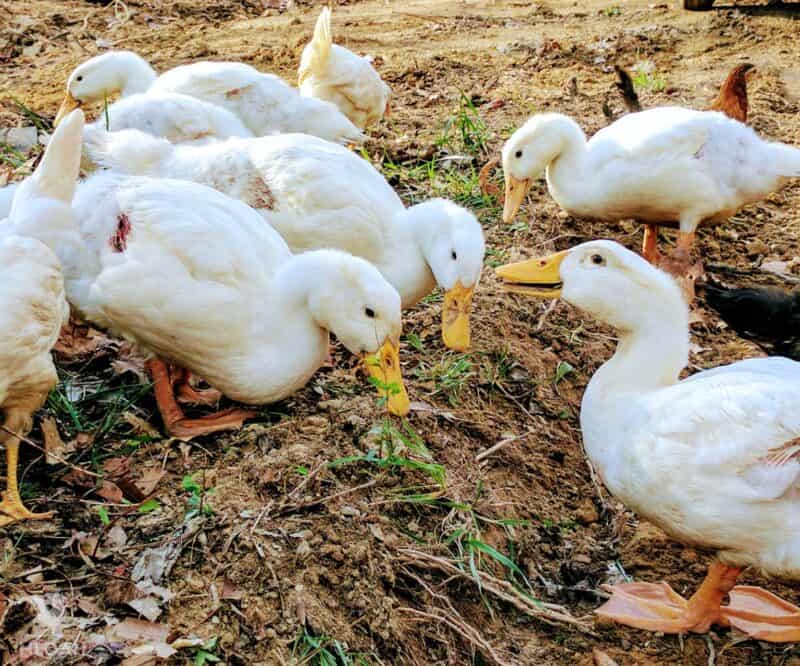
The fuzzy and completely adorable little yellow ducklings you see during “Chick Days” events at Tractor Supply and Rural King are Pekin ducks. While both of these mega-agricultural retailers do sell other breeds of ducks, it is always the Pekins that “fly” right out of the poultry brooders at the stores.
The Pekin duck breed is just as popular with backyard keepers who want these poultry birds basically as “farm pets” with eggs as an afterthought as they are with large acreage homesteaders and commercial farms for both meat and egg production.
In fact, the Pekin duck breed has been so enamored in America that Donald Duck was patterned after them – as well as the enigmatic duck showcased in the AFLAC insurance commercials.
History Of Pekin Ducks
All domesticated duck breeds are largely believed to have stemmed from wild Mallard ducks. The first Mallard ducks were likely kept and domesticated in China before 1,000 AD.
The forced feeding of these poultry birds has also been documented way back to the “Five Dynasties” in China during the tenth century.
Pekin ducks have been raised as meat and egg birds for more than 3,000 years. China is often thought to be the country of origin for these beautiful and hardy ducks, but the exact region in Southeast Asia where the Pekin breed originated is often disputed.
It was in China however, that members of the Pekin duck breed were first exported. Pekins were shipped to Great Britain in 1872, and arrived in the United States of America just a few years later.
It took only a short amount of time for breeders and chefs in both England and America to raise the popularity of these poultry birds.
In the United States, this breed is often referred to as either the Pekin or the Jumbo Pekin based on the size of the variety.
Members of this breed are also often classified as either an American Pekin or German Pekin to differentiate between ducks that come from identical Chinese keepers but went through a slightly altered breeding style.
The American Pekin duck breed is documented and reviewed by the Pekin of the American Poultry Association. The German Pekin breed is reviewed and documented by the Pekin of the Poultry Club of Great Britain.
Walter Steward imported Pekin ducks into Great Britain in 1872. James E. Palmer imported this fine breed to America not long after.
In Germany, Pekin ducks were crossbred with white upright standing ducks that had been imported from Japan. The result of the cross-breeding caused the German Pekins to have a steeply angled body.
The Pekin ducks imported to the United States were crossbred with Aylesbury ducks. This particular breed tends to have a more horizontal stance.
The vast majority of Pekin ducks in England stem from breeders imported from Germany during the early 1970s.
Although still a quite popular breed and Pekin variation, the German Pekin is classified as being “seriously endangered” in Germany, and has been deemed to be “vulnerable” throughout the United Kingdom.
During the past two centuries, the China Pekin ducks which were nearly exclusively raised on Long Island, New York – earning them an additional nickname identifier – Long Island Ducks.
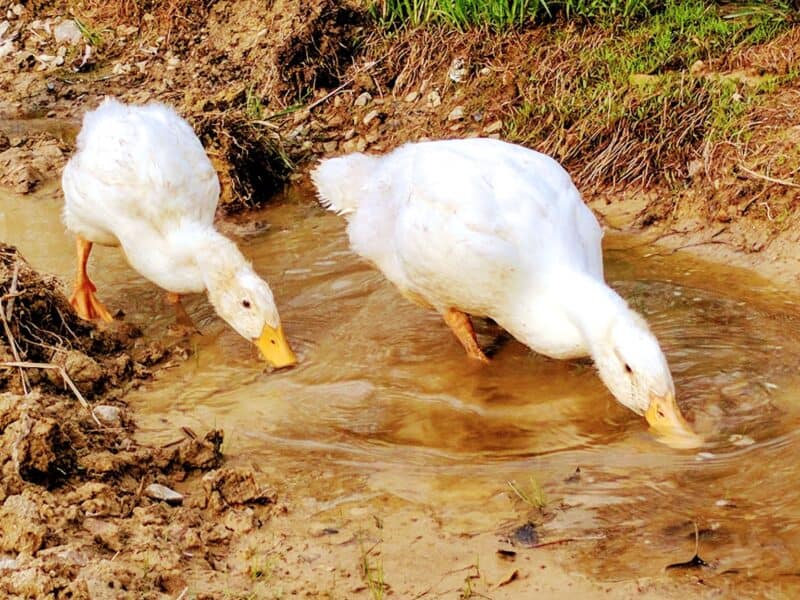
Pekin Duck Breed Facts
- The average lifespan of a Pekin duck (regardless of variety) is about 8 to 12 years.
- While breeding and husbandry routines alter mature duck weight slightly, the average weight of a Pekin hen is between 8 to nine pounds. A mature drake typically weighs in at 10 to 12 pounds.
- Pekin ducks typically produce both larger eggs and an enhanced amount of meat than any other common domesticated duck breed.
- Ducks of this breed are known for their ability to adapt to both cold and hot environments – providing they always have a clean water source to cool off in. Pekin ducks are not only hardy environmentally, but are also known to have a robust immune system when raised in proper sanitary conditions, and on a healthy diet.
Pekin ducks are highly sociable with both each-other, and their human keepers. It is their affable nature that has made them extremely popular farm pets.
A simple Google search will reveal videos of Pekin ducks laying on their back on a keeper’s back drifting off to sleep while getting their tummies gently rubbed.
While I have never had this type of experience with a Pekin duck, I have always found them to be quite happy to see all of their keepers – and even the chickens and guineas that they live with in the same coop and run.
If you handle the Pekin ducklings frequently, they will accept being petted – sometimes.
Ducks of this breed are highly intelligent, the smartest duck breed I have ever raised, actually. They quickly learn who their keepers are, the free-ranging routine, and develop a high level of trust so they run towards you when they see you coming or if they are injured or afraid.
Ducklings quickly meld into the routine of the established flock, and learn when daily turnout occurs, when snack and put up time is, as well as their free-ranging boundaries around the barnyard.
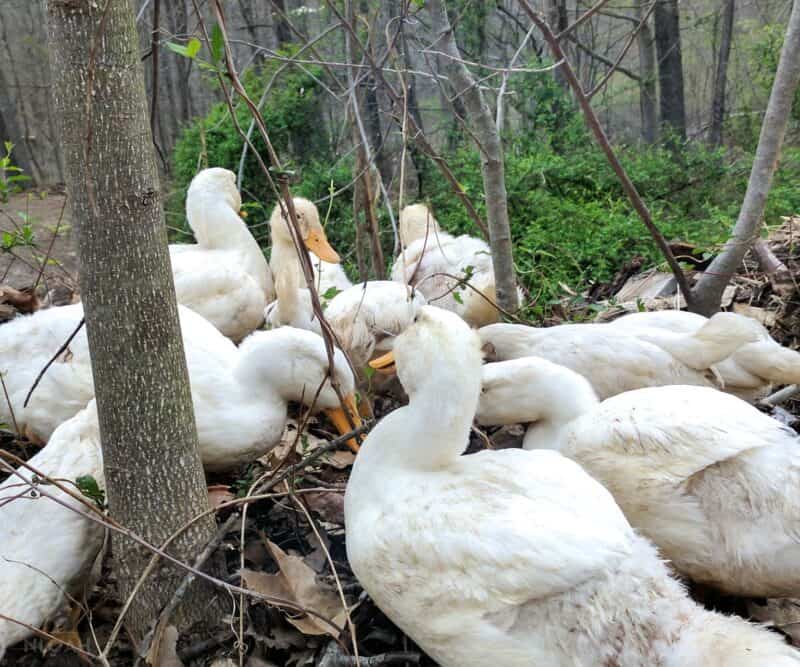
These poultry birds are superb free-rangers. When permitted to free range daily – even during the cold weather months, they regularly forage for at least half of their daily diet.
Growing duck-safe aquatic plants in your pond will allow them to also feed themselves naturally. I like to cultivate aquatic plants in tubs, and rotate them into the pond and duck-run baby pool so I have a steady supply.
The Noise Factor
Pekin ducks are no more noisy or quiet than any other common duck breed – but they can be a bit loud overall for a backyard animal.
Hens tend to be a bit more vocal than the drakes – especially if you are a few minutes late for morning feed time, or tardy to arrive with the healthy snack they were trained to gather for at evening put-up time.
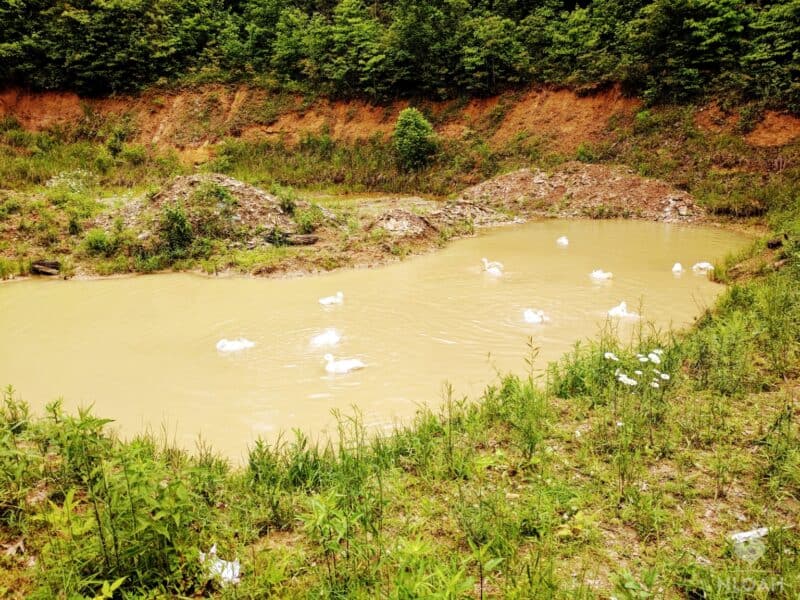
Broodiness
Pekin hens are lousy sitters, that is their only flaw. Once the ducklings are hatched in an incubator however, they are wonderful mothers.
The hens will look after their babies both in their living quarters, and when free ranging on solid ground and in the pond.
Drakes
Pekin drakes (like all drakes) are not aggressive like roosters. This is perhaps another reason why more and more homesteaders are keeping ducks for egg and meat birds instead of chickens.
While you need neither a drake or a rooster for a hen to lay eggs, you do need a mature male to fertilize the eggs to keep flock numbers steady or growing.
Although it can be a major plus that Pekin drakes aren’t as aggressive as a typical rooster, there is also a drawback to this personality trait.
A drake, Pekin or otherwise, is not capable of protecting the other members of the flock either.
In my experience, a Pekin drake does remain on high alert when the duck flock is out free-ranging, and sounds an alarm to alert the others that a threat is near as they all flee to safety.
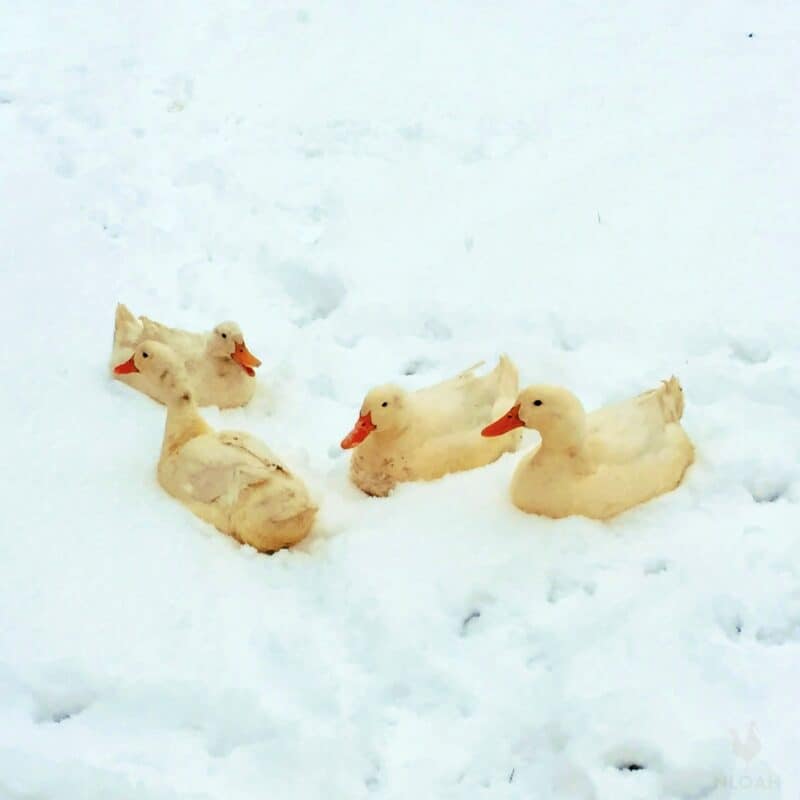
Pekin ducks prefer to spend as much time outdoors as possible – even during the coldest months of the year. It is not the least bit unusual to see your Pekin ducks lounging around in a thick pile of snow, seemingly undaunted by how chilly it is outside.
Ducks of this breed do often prefer to go for short swims, sometimes several times a day even in January or February. Make certain to keep the water in their baby pool or pond thawed so they can swim or wade year round.
All ducks must be able to dip their head and necks into water on a daily basis to remain healthy.
Physical Characteristics
- Pekin ducks come in just one shade of plumage – white. Ducklings are born yellow, but the fuzzy down that covers their bodies morphs into creamy white feathers as they age.
- The orange shanks (legs), toes, and webbed feet of Pekin ducks stay the same color throughout their lives.
- Bills on a Pekin duck are always yellow. Some ducks of this breed, females in particular, can develop some greenish to black speckling on the tip of their bills as they age.
- A Pekin’s body is full-breasted and broad – part of the reason this breed has been deemed a prime type of meat duck.
Pekins As Meat Birds
I keep Pekin ducks for eggs and breeding purposes, but have tasted their meat. The meat produced by this breed is tender, flavorful, and moist.
The meat produced by Pekin ducks boasts a high protein percentage. These ducks produce mostly dark meat that is far less greasy in texture and taste than that of many other duck breeds.
It typically takes only roughly six weeks for a Pekin duck of either gender to mature to butcher weight – about seven pounds.
Jumbo Pekin drakes will usually weigh a minimum of seven pounds and hens nine and a half pounds or more, once fully mature.
A Pekin duck of any variety commonly reaches maturity in approximately 12 weeks. The rapid weight growth associated with the Pekin duck breed is one of the main reasons they are so popular with meat bird breeders.
The faster the duck hits a mature butcher weight, the less you have to spend caring for it and making space for it on the farm.
Chickens were once the meat and bird mainstay of farms and homesteads, but ducks may soon overtake that title.
Ducks not only lay larger and often more eggs-year round than chickens, but produce much more meat per bird – especially the large Pekin breed.
The method of butchering and processing of ducks for meat involves the same steps as with chickens.
The only difference between butchering a Pekin (or any other duck breed) and a chicken is the slightly increased difficulty of plucking the down feathers because they are more dense than chicken feathers.
When butchering a Pekin, duck I highly recommend doing so when pin feathers are either not present, or not entirely pronounced. Some keepers wax or burn the feathers from a harvested duck instead of attempting to pluck them.
Egg Production
Pekin duck hens usually lay between 200 to 310 eggs of a white and extra-large variety, on a yearly basis. Pekin hens commonly start laying eggs once they are roughly five months old.
If the ducklings were born in the late fall and hit the average egg laying eggs during the winter months, the actual laying may be delayed.
To facilitate better egg laying during the cold weather months for hens of any age, install a couple of solar “coop lights” into the living quarters to offer the necessary 8 to 10 daily hours of light to promote good egg laying.
Pekin duck eggs typically weigh three ounces. Pekin hens are notoriously bad at sitting their own eggs. It would be far more unusual for such a hen to sit eggs to hatch than to not.
In my experience, what often happens is a Pekin hen collects all her eggs and anyone she can steal from other hens and puts them in a big pile. Expecting a duck hen to lay eggs in a nest like a chicken hen will be nothing but pure folly.
Once she has a clutch of eggs, the Pekin hen might sit them for a few hours every day, or even nearly an entire day once every few days. Such tactics will not lead to the hatching of the clutch of eggs.
If you want to hatch Pekin chicks you will need to collect the eggs yourself – from a sporadically protective momma hen.
A fertilized Pekin duck egg can remain viable for hatching seven to 10 days after it has been laid – depending upon the temperature.
Ducks, unlike chickens, almost always lay eggs between sunset and sunrise. Knowing when the eggs are laid will help you hunt them all up each morning before they can be trampled and crushed by the waddling flock.
Walk carefully around the run and duck coop, especially if you have a lot of fresh bedding on the ground to sop up all the mud ducks create from getting in and out of their in-run baby pool.
A duck hen will stop and lay an egg whenever the urge strikes and then simply walk away from it at least half of the time.
When a hen takes an urge to sit eggs for a while, she is fully capable of packing them wherever she wants to go. Make sure to look everywhere in the coop and run for eggs. Female Pekin ducks can tote eggs in their bills not only a long way, but even up ramps.
The pie crusts, cupcakes, noodles, and casseroles that you make using Pekin duck eggs will likely become family favorites thanks to the rich and creamy flavor that will now be infused in all of the recipes.
Pekin Duck Diet
There are no special dietary needs for the Pekin duck breed. In fact, the more naturally you let them feed the better their health will be and the cheaper it is for the keepers.
Allowing the Pekin duck flock to free range for at least a few hours per day will provide them with the high quality of protein they need in their diet, while ridding your yard or garden of bugs. It will also provide them with an extra layer of fat to keep them warm during the winter.
Some of a Pekin duck’s favorite foraging snacks include slugs, small crustaceans, mosquitoes, crickets, worms (mealworms), snails, flies, tadpoles, small frogs, small lizards, and ants.
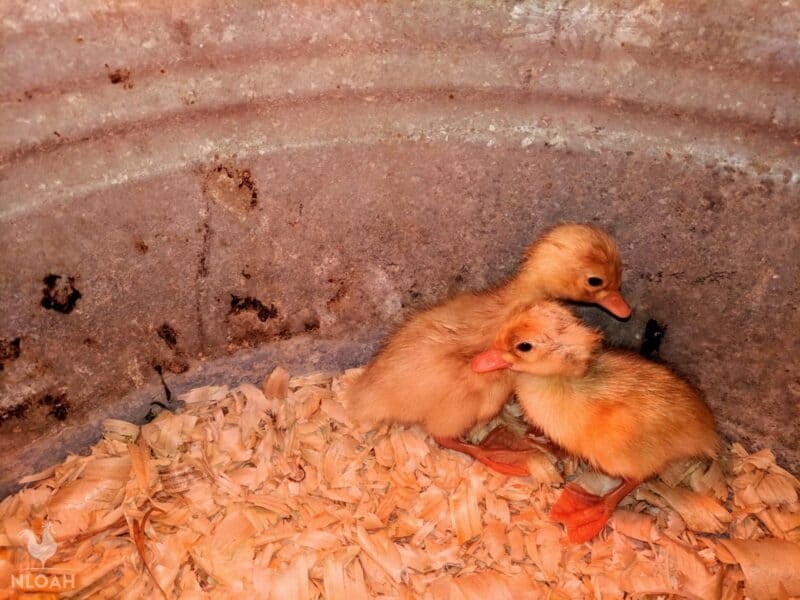
Finding waterfowl feed, especially for ducklings, can be quite difficult – especially in rural areas. A Pekin duck can be fed any type of chicken feed – but the scratch variety can be difficult for them to consume due to having a bill and not a pointy beak.
Pellet or crumble feed is far easier for a Pekin duck to eat, especially when they are juveniles. Ducklings should never be fed medicated chick starter, but they can consume non-medicated chick starter.
Providing Pekins feed during the winter months, when protein sources will be decidedly limited, will help keep the meat and egg birds healthy and strong.
Feeding the ducks, especially the hens, their own cracked egg shells can boost their calcium intake during cold weather months, and help them to lay eggs with a sturdier and thicker shell.
When training a flock of Pekin ducks to free range, some of their favorite and healthy snacks that can help get the job done quickly include lettuce, grapes, peas, and corn. Do not feed ducks commercially canned vegetables because of the high sodium count they contain.
Living Quarters
Pekin ducks will need either a duck house or a duck coop that protects them from the elements and predators. I keep my duck flock in the same coop and run as my chickens and guineas.
Unlike chickens, ducks do not need a tall housing area, since they cannot fly. Individual nesting boxes are also not necessary. Pekin ducks will rarely (never in my experience) lay eggs in a nesting box.
I did put some tires in the coop for the ducks, and filled them with hay to give them a defined sleeping area. The tire and hay combo could serve as a nest to lay eggs in, if the Pekin hens so choose.
As already noted, Pekin ducks will spend far more time outdoors than not only chickens, but many other breeds of ducks despite chilly temperatures.
I have discovered that while Pekin ducks prefer to mate in the water or in the rain, they do not like being outside without shelter when it is raining hard – they don’t like heavy rain or thunderstorms.
The run attached to the duck house or coop should include a portion that is covered so the members of the Pekin flock can remain outdoors, but not be subjected to being pelted by rain or sleet.
You will also need to provide dry and clean bedding inside of the duck house or duck coop year-round. Expect to replace bedding more often when keeping ducks instead of chickens.
Ducks, and Pekins in particular, do a lot of splashing in their baby pool, and even in with a fountain-style waterer while slurping from it.
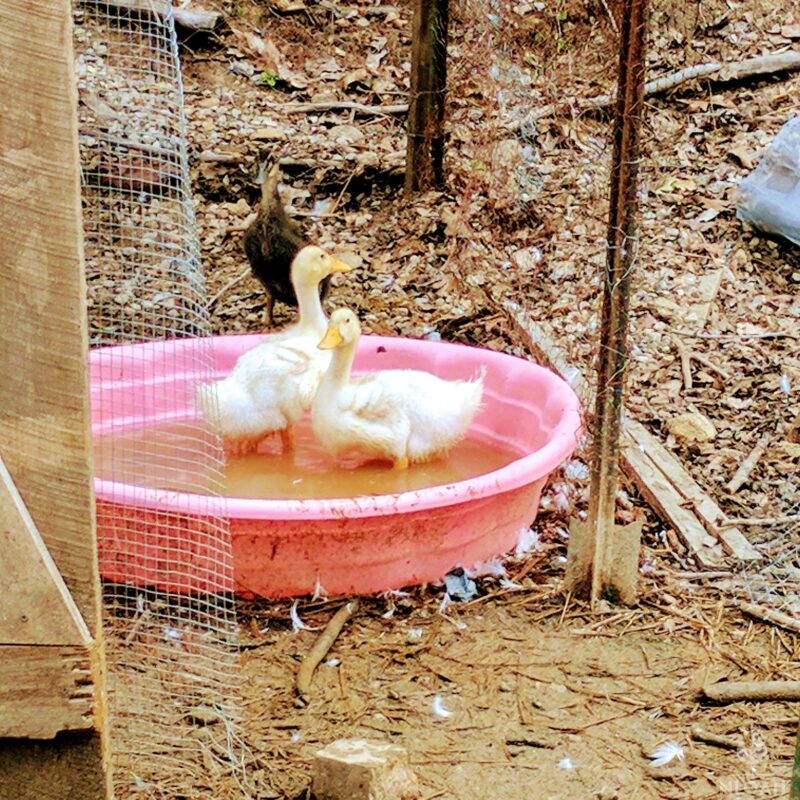
The ground in the coop run and inside of the living quarters will get damp, wet, and dirty frequently. Expert to be addressing bedding issues about once every week or two, depending upon how long and how often the flock of Pekin ducks is allowed to free range.
Get Pekins (Seriously)
Pekin ducks are an excellent multi-purpose breed. They will offer your homesteading family a steady source of calcium-rich eggs as well as quality meat
These intelligent and sociable birds also make a great first farm “pet” for youngsters to learn to care for while learning a sense of responsibility and garnering a grasp of the farm-to-table process.
Pekin Ducks FAQ
Pekins will only lay one egg a day.
yes, Pekins are consistent egg layers, and will continue to do it even during the winter months.
Definitely, they will lay eggs as they normally would, and the eggs will be edible, though unfertilized.


Tara lives on a 56 acres farm in the Appalachian Mountains, where she faces homesteading and farming challenges every single day, raising chickens, goats, horses, and tons of vegetables. She’s an expert in all sorts of homesteading skills such as hide tanning, doll making, tree tapping, and many more.
